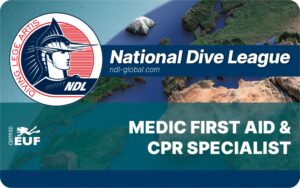MEDIC FIRST AID AND CPR COURSE $189
Most people will be involved in a crisis at some point in their lives, whether it’s being on the scene of an accident or seeing a medical emergency. People with first aid training and incident management abilities are more likely to step up and take action if these scenarios develop. NDL’s courses are straightforward to grasp and designed to provide you with the skills and confidence you need to respond in an emergency. They were created by dive medicine physicians and diving educators. NDL first aid courses prepare students to address scuba diving accidents as well as those that arise in other situations. All courses adhere to current ILCOR and AHA standards. Isn’t it worthwhile to spend a few hours one evening or weekend learning skills that could save a life?
CONTACT US
Basic Life Support: CPR and First Aid (BLS)
Basic Life Support (BLS) is a set of medical procedures used in emergency situations to sustain life in individuals experiencing cardiac arrest or respiratory failure. Cardiopulmonary resuscitation (CPR) is a key component of BLS and involves chest compression’s and rescue breaths to keep blood and oxygen flowing when the heart and lungs have stopped working.
Here’s a breakdown of basic life support and CPR:
- Chest Compressions: High-quality chest compressions are crucial to maintain blood circulation. The rescuer places the heel of one hand on the center of the chest (usually just below the nipple line) and places the other hand on top. Compressions are performed at a rate of about 100-120 compressions per minute.
- Rescue Breaths: These are given after a set of chest compressions. The rescuer provides two rescue breaths by tilting the head back slightly, lifting the chin, and giving breaths over the victim’s mouth while pinching the nose shut.
Emergency Oxygen for Scuba Diving Injuries (EO2)
Administering emergency oxygen is the preferred first aid for scuba diving injuries, and early administration can drastically improve the outcome for an injured diver. The NDL Emergency Oxygen for Scuba Diving Injuries course teaches you how to administer life-saving oxygen first aid to divers who may be suffering from decompression illness (DCI). Additionally, this course will teach you how to recognize the signs and symptoms of decompression illness and respond to them accordingly. The emergency response skills taught in this course are not unique to scuba diving; they’re applicable to many other water-sports and other activities.
-
Importance of Emergency Oxygen: In scuba diving, accidents can happen, such as decompression sickness, lung over expansion injuries, and other breathing-related problems. Administering emergency oxygen can help mitigate these issues and stabilize the injured diver’s condition.
-
Oxygen Administration: Oxygen should be administered as soon as possible after a diving injury. The standard procedure is to provide 100% oxygen through a demand valve or a non-rebreather mask. The goal is to increase the concentration of oxygen in the body, which aids in off-gassing nitrogen and preventing hypoxia.
-
First Aid Training: It’s essential for divers, dive professionals, and anyone involved in water activities to receive proper training in first aid and oxygen administration. Many scuba diving certification agencies offer courses that cover these skills, such as “Emergency Oxygen Provider” courses.
-
Oxygen Equipment: Portable oxygen kits suitable for scuba diving emergencies often include a cylinder of medical-grade oxygen, a regulator, a mask, and instructions for use. These kits are designed to be compact and easily transportable.
-
Decompression Chambers: In severe cases, where a diver shows symptoms of decompression sickness (“the bends”), the injured diver may need to be transported to a hyperbaric chamber for more intensive oxygen treatment. These chambers provide a controlled environment for administering oxygen at higher pressures to facilitate nitrogen off-gassing.
-
Contacting Medical Professionals: While administering emergency oxygen is crucial, it’s important to seek medical assistance for the injured diver as soon as possible. Diving injuries can have complex effects on the body, and a medical professional’s evaluation is vital for proper diagnosis and treatment.
-
Safety Precautions: When handling oxygen and oxygen equipment, safety precautions must be followed. Oxygen supports combustion, so there’s a risk of fire. Ensure that the equipment is well-maintained,
Diving First Aid for Professional Divers (DFA Pro)
Professional divers have unique responsibilities and a duty to respond to unique situations; their first aid training should not be any less unique. NDL’s Diving First Aid for Professional Divers course is designed for commercial, professional, aquarium, and scientific divers, and it provides knowledge and first aid skills specifically for these work environments. Pro includes all elements of the BLS and EO2 courses and includes material on neurological assessment and first aid for hazardous marine life injuries. In the neurological assessment portion of the Pro course, you will learn how to properly manage injuries with neurological implications. You will learn to recognize these injuries and properly perform a neurological assessment. You’ll also learn what information to collect and relay to emergency medical services. Recognizing symptoms and responding quickly can shorten recovery times and improve long-term outcomes. In the hazardous marine life injuries segment, you will gain the knowledge you need to identify specific types of marine life injuries and the first aid skills to treat them. Pro Training With Diving VietNam is one of the most comprehensive first aid course in the dive industry. While geared toward dive instructors and dive masters, anyone, will learn an indispensable set of first aid and risk-mitigation skills. CONTACT ME
[/vc_column_text][/vc_column][/vc_row]
